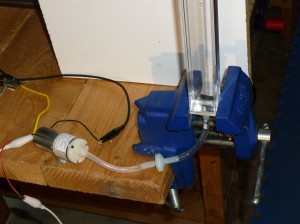The nozzle size has an effect on the amount of air (expressed in milliseconds of pump activation) that will form into a single bubble. In water, even if you launch a stream of several bubbles, they typically join together relatively quickly to form a single bubble. However, with Glycerin the bubbles are more likely to separate, and the smaller bubbles rise slower, eventually getting caught and integrated into a larger following bubble. By increasing the nozzle size from a 1/8 inch hose barb to a 1/4 inch hose barb, I found that I could create larger more regular bubbles, and launch them closer together (temporally and vertically).
I also switched my nozzle material from Nylon (which acrylic weld won’t weld, and required the use of epoxy) to Clear Polycarbonate, which acrylic weld WILL weld. This allows me to use a single welding solvent to construct the entire tube assembly, and gives me more confidence in the bond. (Although the Epoxy appears to be working well….) Because they are clear I can visually inspect the weld between the bottom of the tube and the nozzle. Also, they blend into the acrylic bottoms of the tubes and give a much nicer visual appearance. The specific part I used to get both polycarbonate and a 1/4″ output was a Single-Barbed Reducing Coupling for 1/4″ X 1/8″ ID Tubes. The nylon 1/8″ nozzle cost 0.26 USD, the same part in clear polycarbonate is 0.47 USD, and if you want a 1/8″ to 1/4″ coupling it costs 0.70 USD, so the cost for the larger clear nozzle is nearly triple the plain old nylon part, but as a percentage of the total tube cost it is negligible.

